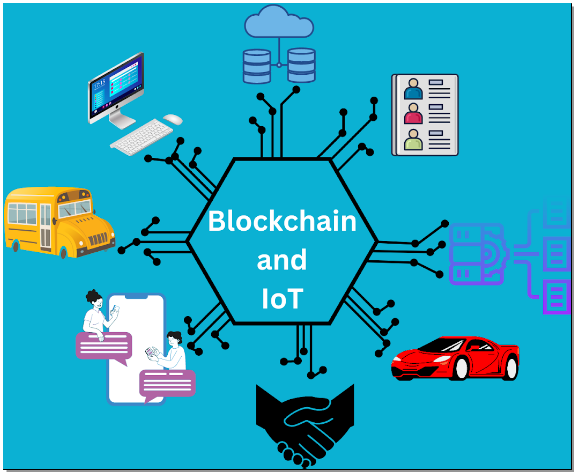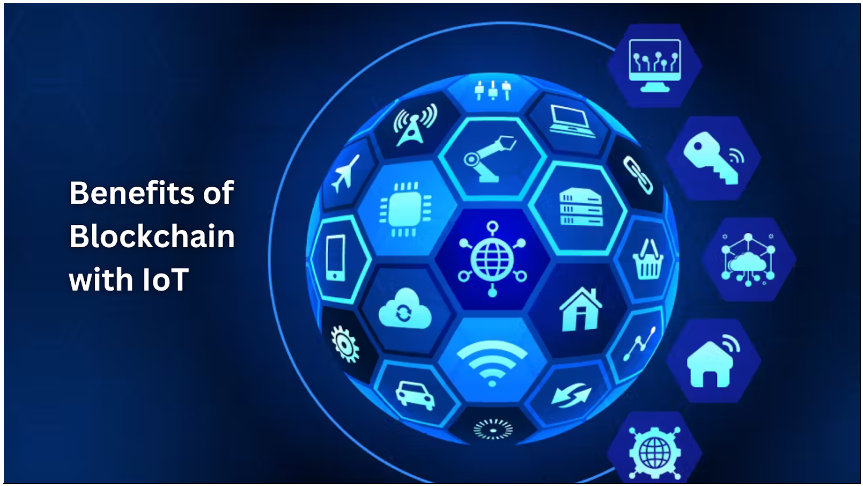BLOCKCHAIN AND IOT
The convergence of blockchain and IoT technologies is poised to revolutionize various industries, leading to rapid growth and transformation. The market for blockchain in IoT is projected to experience significant expansion in the coming years, with remarkable CAGR rates in various sectors such as security, healthcare, and supply chain management. With the increasing adoption of blockchain IoT solutions, we can expect to see major advancements in the way devices communicate and collaborate, while enhancing transparency, efficiency, and security across industries.

The global Blockchain in IoT market is expected to reach $2.4 billion by 2026, with a 45% CAGR. The number of connected IoT devices is expected to rise to 4.7 billion by 2029, with a 5.3% CAGR. The market is expected to impact security, healthcare, and supply chains, with security applications reaching $1.2 billion by 2028 and supply chain market size at $16.7 billion by 2030. So, The Blockchain IoT market is expected to grow from $0.57 billion in 2023 to $3.44 billion by 2028. (Markets, 2023) (Simmons, 21 january 2023)
Blockchain and IoT
- Internet of Things (IoT) refers to a network of smart devices that collect data from sensors and share this information over the internet. This connectivity allows for the automation and control of various systems and processes, making our lives more convenient and efficient.
- Blockchain acts like a digital ledger, ensuring that new digital pages (blocks) are valid and accurately added to the ledger. This ledger serves as an ultra-secure digital record book that documents all network transactions using advanced cryptography.
The combination of the Internet of Things (IoT) and blockchain technology is changing the way we connect and communicate. Blockchain-powered IoT ensures reliable authentication, secure data storage, and data sharing among connected devices. It uses a highly secure digital ledger to protect data from tampering or corruption, providing a trustworthy foundation for IoT interactions.
How does IOT fit into blockchain technology?
Even the Internet of Things has affected your life, changing our digital lives. However, as IT evolves, it brings with it data security challenges. With technological advancements, cybercriminals are also getting more sophisticated, finding new ways to breach privacy and access sensitive information. For instance, connected healthcare devices that collect patient data and transmit it to doctors via the internet become vulnerable points for hackers eager to exploit this valuable information. While connected devices and the Internet of Things offer incredible benefits, they often fall short in terms of the security and authentication measures necessary to safeguard user privacy. To ensure user protection, it is imperative to establish, uphold, and standardize enhanced security measures for IoT and connected devices.
Blockchain technology finds valuable applications in the realm of IoT. It enables the monitoring of sensor data while providing a robust defense against hackers attempting to integrate it with malicious data. Moreover, IoT facilitates the direct transmission of data over a dedicated blockchain, bypassing the need for intermediary platforms. By doing so, blockchain significantly reduces the risk of data breaches. Hackers face significant obstacles when attempting to access and manipulate data stored on blockchains. This is due to the unique and unalterable signatures imprinted within blockchain technology. Furthermore, blockchain enhances data security by dispersing it across multiple locations simultaneously, effectively shielding private information from unauthorized access or leakage.
Blockchain and IoT Integration Strategies
Before integrating blockchain into an Internet of Things (IoT) architecture, it’s crucial to consider the interaction between these technologies. There are three approaches to this integration:
- IoT-IoT In this strategy where IoT devices continue to operate without significant changes. A shared blockchain ledger is used for storing IoT data, but data transfer occurs outside the blockchain through various routing techniques. This approach offers benefits like reduced delays, quick transaction speeds, and the ability for IoT devices to operate offline. Implementation involves setting up blockchain data storage and transmission in place of traditional servers or cloud solutions.
- Blockchain-IoT The blockchain becomes the primary communication facilitator for IoT devices here. IoT devices communicate through the blockchain, enhancing automation, security, traceability, and scalability. However, if the blockchain lacks speed, it can complicate the system and introduce delays. This approach requires significant adjustments to both IoT device operation and blockchain development. A suitable blockchain with high processing speeds, capacity, and low fees is necessary for efficient integration.
- Hybrid Approach The hybrid approach involves a combination of both IoT and blockchain technologies. The blockchain stores a portion of the data, while IoT devices exchange a significant amount of their data directly. While offering several advantages, this method may not support real-time operations with minimal delays. To overcome limitations, fog computing can be introduced, allowing peripheral devices to collect, store, and analyze data, reducing operational costs compared to traditional cloud computing.
Each approach has its own set of advantages and challenges, and the choice depends on the specific use case and the desired balance between decentralization, security, and efficiency in IoT applications. Whether it’s maintaining IoT device operations as is, adopting blockchain-IoT communication, or utilizing a hybrid model, the goal is to enhance the reliability and trustworthiness of IoT data while optimizing data storage and exchange.
What are the Benefits to implement Blockchain with IoT?

| Decentralization | Blockchain technology enables decentralization, providing the Internet of Things (IoT) network with added resilience. This reduces the risk of data loss and helps prevent network downtime, ensuring the continuous operation of IoT devices even in adverse conditions. |
| Transparency | With a shared and tamper-proof ledger, all stakeholders can verify the accuracy of data and transactions. This transparency is invaluable in supply chain management, where consumers can trace the journey of products from origin to their hands. It also enhances trust in data coming from IoT devices, making them more reliable for critical applications. |
| Automation | The combination of blockchain and IoT reduces processes and eliminates intermediaries. Smart contracts, self-executing agreements triggered by predefined conditions, automate tasks in response to real-time IoT data. This automation reduces administrative overhead, minimizes errors, and accelerates processes. |
| Security and privacy | IoT devices are susceptible to security breaches, and data privacy is a significant concern. Blockchain’s cryptographic security measures provide robust protection against unauthorized access and data tampering. Each transaction is recorded in an immutable ledger, ensuring the integrity of the data. |
Challenges in adopting Blockchain with IoT
The integration of IoT and blockchain faces several challenges:
- Scalability is a significant hurdle, as blockchain’s transaction processing capacity can lead to delays and congestion in IoT networks.
- IoT devices’ interoperability is also a concern, as they utilize various communication protocols that may not align with blockchain standards.
- Cost is another issue, given the substantial processing and storage requirements of blockchain technology.
- High energy consumption during blockchain block mining is impractical for low-power IoT devices.
- The absence of uniform legal frameworks can create confusion and legal complications, especially regarding data security and privacy.
The integration of IoT with blockchain holds immense potential for revolutionizing how we interact with connected devices and manage data. The combination of these technologies offers increased security, transparency, and trust in various industries, from supply chain and healthcare to security and industrial processes. However, this partnership is not without its challenges, including scalability, interoperability, cost, and energy usage. Overcoming these obstacles will require collaboration between the IoT and blockchain communities and the development of innovative solutions.
As technology continues to advance, we can anticipate more seamless and efficient ways to harness the full potential of blockchain in the realm of the Internet of Things. The journey to fully realizing this potential is ongoing, but the possibilities are boundless, promising a future where our connected world is safer, more accountable, and more transparent.